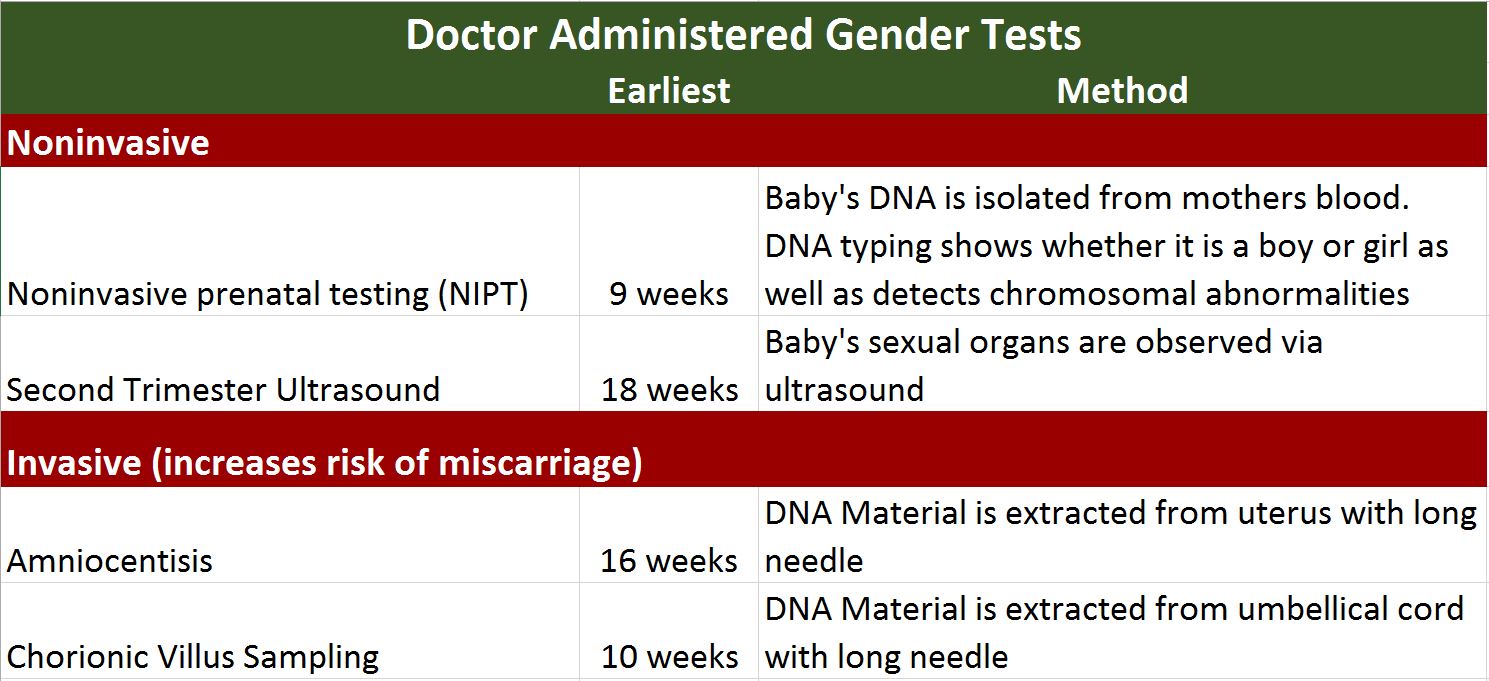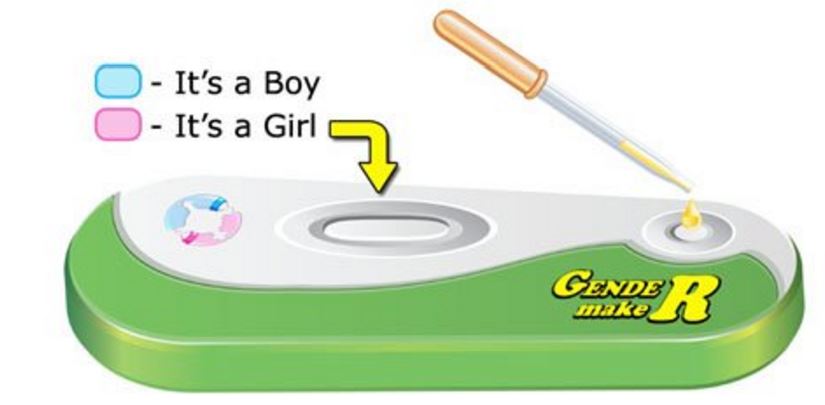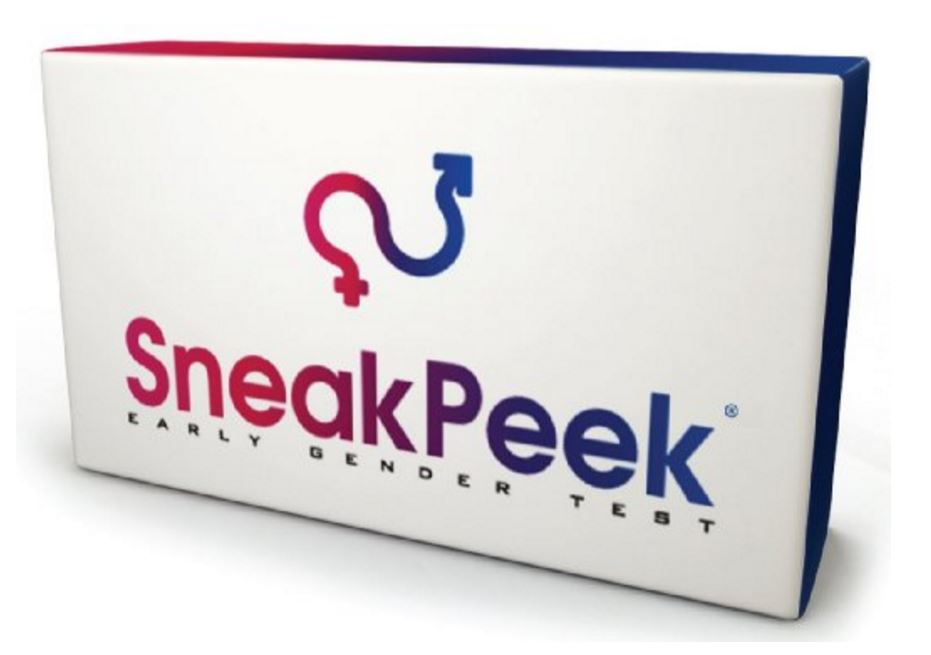Pregnancy Gender Test

Today the most accurate early pregnancy gender test is performed by your doctor at 8-9 weeks of pregnancy. It used to be that you had to wait until you were 16 to 18 weeks into your pregnancy before you could find out whether you were going to have a boy or a girl. Now you can find out much earlier with a simple blood test!
When it comes to gender testing there are four tests that can be performed by your doctor that are highly accurate. They include Noninvasive prenatal testing (NIPT), Amniocentisis, Chorionic Villus Sampling and a Second Trimester Detailed Ultrasound.

Both amniocentesis and chorionic villus sampling are highly invasive diagnostic tests that elevate your risk of miscarriage and are recommended only for moms who are higher-risk for carrying a baby with chromosomal abnormalities. They are not designed for parents who are simply curious about their baby’s gender. However if you are a higher risk mom who needs to have either test, the results can tell you your baby’s gender with 100 percent accuracy.
Get all of our best pregnancy tips. Download our free e-guide today!
Learn how to avoid Gaining too much weight, strategies for Avoiding gestational diabetes and secrets for an easy delivery.
Invasive Pregnancy Gender Tests
Amniocentisis is performed by inserting a long thin needle into your uterus and extracting approximately an ounce of amniotic fluid from the amniotic sac surrounding your baby. You baby’s DNA is extracted from the fluid that provides both information regarding your baby’s sex (XX for a girl, XY for a boy) as well as if there are any genetic disorders.
Chorionic villus sampling (CVS) is performed by taking a sample of chorionic villi from the placenta. The sample can be taken through the cervix (transcervical) or the abdominal wall (transabdominal). Chorionic villi are wispy projections of placental tissue that share the baby's genetic makeup. DNA is extracted from the tissue that provides both information regarding your baby’s sex as well as if there are any genetic disorders.
Need to Talk To Someone?
Do be very specific or personal questions you do not feel comfortable discussing in public forums? If so, please meet signing up for a 60 minute mentoring session.
Pregnancy & Childbirth Mentoring
You will be amazed at the Amount of information and can gain confidence in just a few minutes of one-on-one help.
Non-Invasive Pregnancy Gender Tests
Noninvasive prenatal testing (NIPT) is a screening test performed as early as 9 weeks along through a simple blood draw. Did you know that pieces of your baby’s DNA circulate in your blood? It is that DNA that is used to determine your baby’s sex (XX for a girl, XY for a boy) as well as whether or not your baby has any of the usual generically transferred disorders like Downs Syndrome (trisomy 21) or Edwards Syndrome (trisomy 18) . Depending on your age and health status, your medical insurance may not cover NIPT, so be sure to ask your doctor.
Until recently, most women found out the gender of their baby during their second trimester ultrasound. At this point baby is big enough and his or her sexual organs are developed enough to be observed via ultrasound. However this is not 100% reliable since baby needs to be in a position where the genitals can be viewed. Many prospective parents have had babies that “hide the goods”. Although the second trimester ultrasound can tell you the gender of your baby, its real usefulness is in determining the overall health and of development of your baby.
Other pregnancy gender test methods
There are a variety of pregnancy gender test kits available online that use either a urine sample or blood sample measure the amount of testosterone in your urine or the presence of male-specific DNA in your blood.

These pregnancy gender test methods are all less accurate than the above tests. However, if you are not a high risk mom, the gender prediction test kits that you can buy online can detect gender with varying degrees of accuracy. In general the tests that use blood samples are more accurate than the ones based on a urine sample.
Urine Sample Based Gender Prediction Kits
The urine based pregnancy gender test is the least accurate. They also cost the least, typically between fifteen and forty US dollars. The test is easy to perform. You urinate in a cup, extract the urine with the pipette provided in the test kit and apply the prescribed number of drops to the area indicated and wait for a few minutes.
The test measures the amount of testosterone in your urine. Since there are many variables that can influence the amount of testosterone in your blood, these tests are not especially accurate, but they are fun to try.
Blood Sample DNA Gender Test Kits
A blood sample based pregnancy gender test costs more and is more accurate. Surprisingly accurate as a matter of fact and some, like our favorite, the SneakPeek Early Gender Prediction DNA Test will guarantee their results.
The blood sample test kits are also easy to use albeit a bit more painful since it requires a finger stick to extract blood. They range in price from $75 for SneakPeek to over $200 US dollars. The test detects the presence of male-specific DNA in your blood. Since you are female, male DNA in your blood will definately indicate you are carrying a boy. Depending on the type of genetic sequencing used (do they exclude your DNA?) they may not be as accurate if you are carrying a girl.












New! Facebook Comments
Tell us what you think!